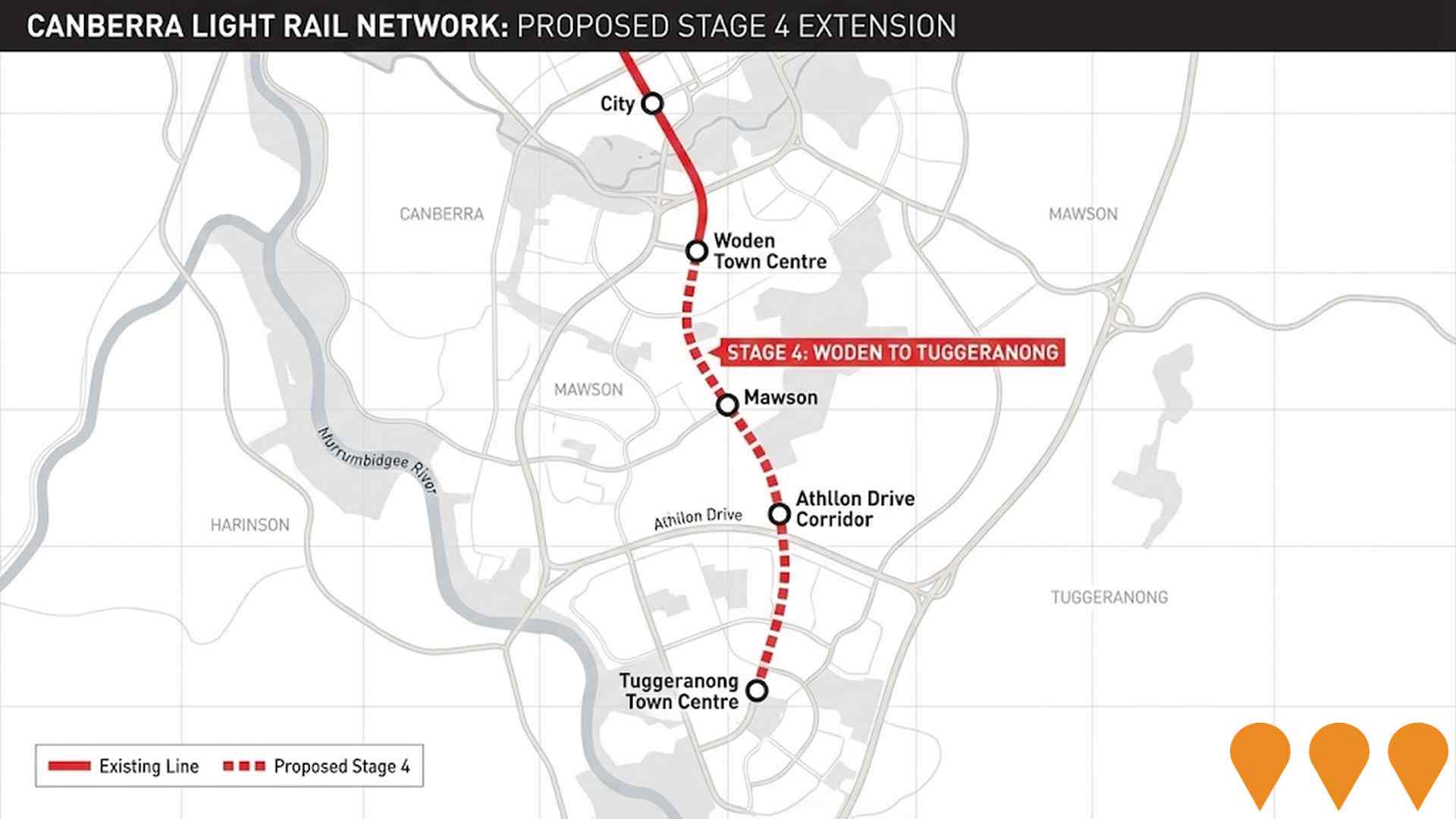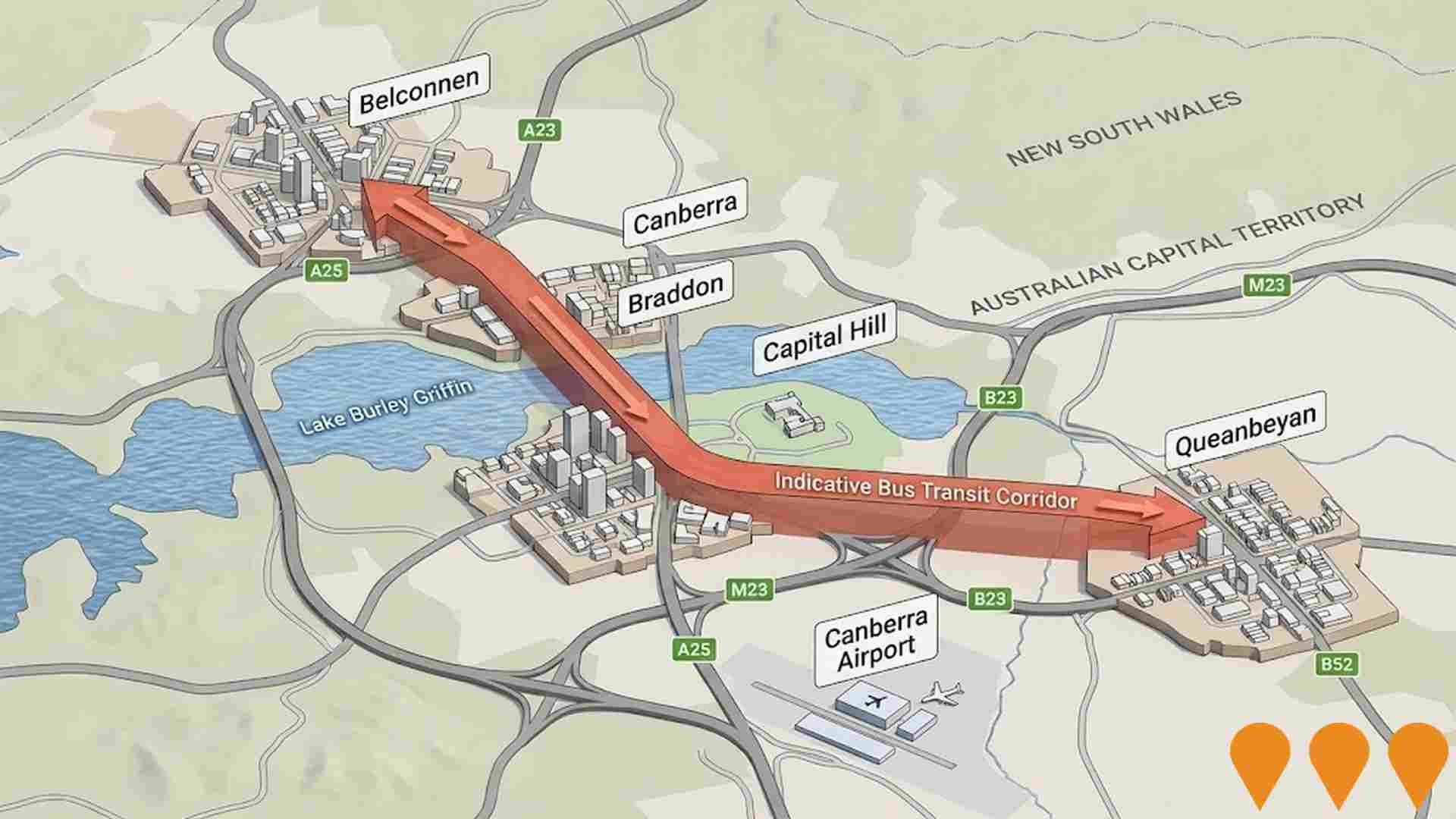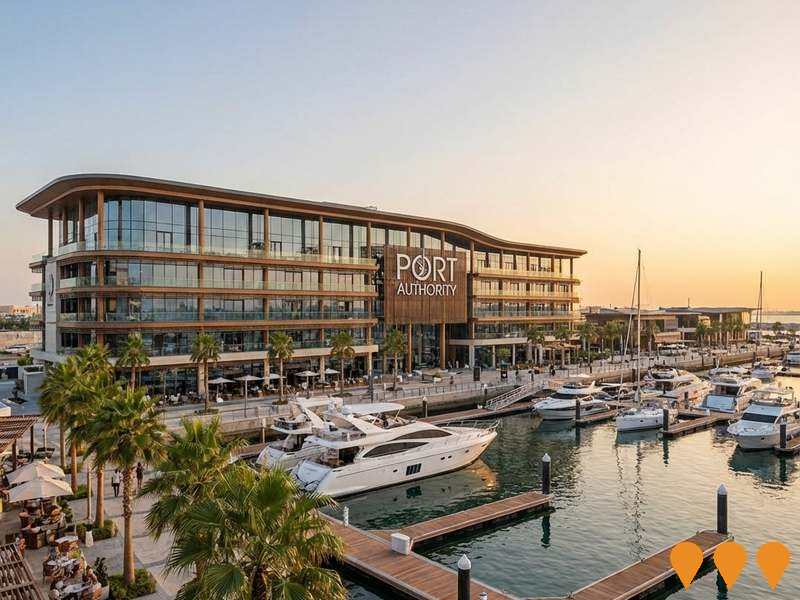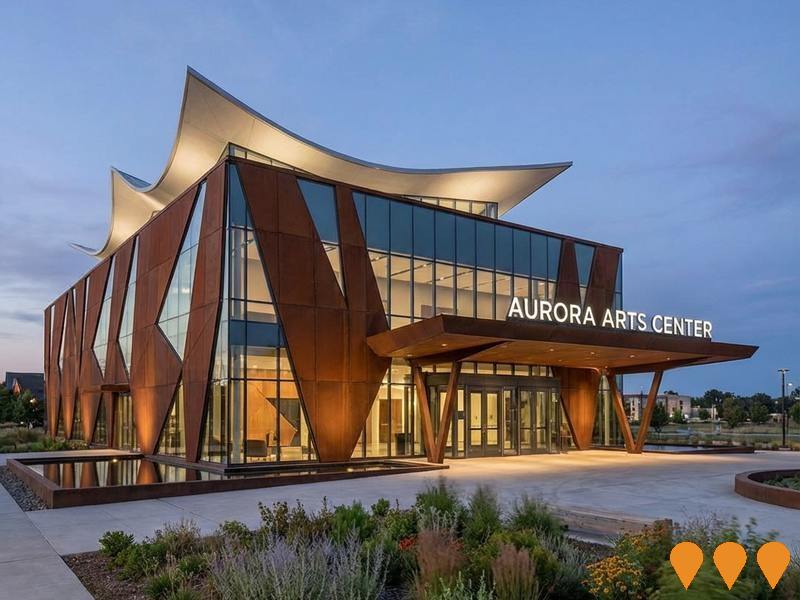Chart Color Schemes
est. as @ -- *
ABS ERP | -- people | --
2021 Census | -- people
Sales Activity
Curious about local property values? Filter the chart to assess the volume and appreciation (including resales) trends and regional comparisons, or scroll to the map below view this information at an individual property level.
Find a Recent Sale
Sales Detail
Population
Isaacs has shown very soft population growth performance across periods assessed by AreaSearch
Isaacs's population was 2,346 as of August 2025, a decrease of 33 people from the 2021 Census figure of 2,379. This change is inferred from ABS estimated resident population data of 2,346 in June 2024 and address validation since the Census date. The population density was 759 persons per square kilometer, comparable to averages across locations assessed by AreaSearch. Overseas migration contributed approximately 76.6% of overall population gains during recent periods. AreaSearch adopted ABS/Geoscience Australia projections for each SA2 area, released in 2024 with a base year of 2022.
For areas not covered and years post-2032, age group growth rates from ACT Government's SA2 area projections were used, also based on 2022. By 2041, the population is projected to decline by 220 persons. However, specific age cohorts are expected to grow, notably the 85 and over age group, projected to expand by 41 people.
Frequently Asked Questions - Population
Development
The level of residential development activity in Isaacs is very low in comparison to the average area assessed nationally by AreaSearch
Isaacs has seen minimal dwelling approvals in recent years, with a total of 2 homes approved over the past five financial years. As of FY-26, 0 approvals have been recorded to date. The population has fallen during this period, indicating that new supply may be meeting demand and offering buyers good choice, despite new homes being built at an average construction cost value of $100,000, which is below regional norms, suggesting more affordable housing options for purchasers.
Compared to the Australian Capital Territory, Isaacs has significantly less development activity. This scarcity typically strengthens demand and prices for existing properties, although development activity has increased in recent periods. Nationally, this level of activity is below average, reflecting the area's maturity and possible planning constraints.
Population projections indicate stability or decline, which should reduce housing demand pressures, benefiting potential buyers.
Frequently Asked Questions - Development
Infrastructure
Isaacs has strong levels of nearby infrastructure activity, ranking in the top 30% nationally
Changes to local infrastructure significantly impact an area's performance. AreaSearch has identified one major project likely affecting this region: Canberra Hospital Master Plan, Mixed-Use Complex In Mawson, Affordable Housing Project Fund, The Centenary Hospital for Women and Children Expansion Project.
Professional plan users can use the search below to filter and access additional projects.
INFRASTRUCTURE SEARCH
 Denotes AI-based impression for illustrative purposes only, not to be taken as definitive under any circumstances. Please follow links and conduct other investigations from the project's source for actual imagery. Developers and project owners wishing us to use original imagery please Contact Us and we will do so.
Denotes AI-based impression for illustrative purposes only, not to be taken as definitive under any circumstances. Please follow links and conduct other investigations from the project's source for actual imagery. Developers and project owners wishing us to use original imagery please Contact Us and we will do so.
Frequently Asked Questions - Infrastructure
Canberra Hospital Master Plan
Long-term transformation of Canberra Hospital campus (2021-2041). The new Critical Services Building (Building 5) opened in 2023. Multiple stages are now in construction or detailed planning, including SPIRE Stage 1 (new emergency, surgical and intensive care facilities) and ongoing campus renewal works to deliver modern clinical facilities.

Canberra Light Rail Stage 4 - Woden to Tuggeranong
Proposed extension of Canberra's light rail network from Woden Town Centre south to Tuggeranong Town Centre via Mawson and the Athllon Drive corridor. This future stage aims to complete the north-south radial mass transit spine, connecting major residential, employment and activity centres while supporting bus, cycling, walking and private vehicle integration.

Canberra Hospital Critical Services Building (SPIRE Centre)
Australia's first fully-electric hospital building, the Canberra Hospital Critical Services Building (also known as SPIRE Centre), is an eight-storey, 45,000 square metre facility. It includes a new Emergency Department with 128 treatment spaces, a 48-bed Intensive Care Unit with two outdoor terraces, 22 operating theatres, 148 inpatient beds, cardiac catheter laboratories, and enhanced radiology and pathology services. The largest healthcare infrastructure project in ACT history, it was built by Multiplex with a 5 Star Green Star design rating, featuring innovative sustainability measures. Completed and opened August 2024.

Enhanced bus and light rail corridors (Belconnen & Queanbeyan to Central Canberra)
ACT is progressing an integrated program to enhance high-frequency bus and future light rail corridors that link Belconnen and Queanbeyan with central Canberra. Light Rail Stage 2A (City to Commonwealth Park) commenced construction in early 2025 with services targeted from 2028, while planning and approvals continue for Stage 2B to Woden. The ACT Government has acknowledged and is planning upgrades for the Belconnen-to-City bus corridor as groundwork for a future east-west light rail Stage 3, and is coordinating cross-border public transport initiatives with NSW through the Queanbeyan Region Integrated Transport Plan and the ACT-NSW MoU for Regional Collaboration.

Deakin Private Hospital
Deakin Private Hospital offers premium and integrated inpatient, day therapy, and hospital-in-the-home services, focusing on individualised and high-quality mental health treatment. It includes a Specialised PTSD & Trauma Support Unit for military and first responders, and services such as Repetitive Transcranial Magnetic Stimulation (rTMS) for depression. The hospital also features co-located clinics and is supported by a multidisciplinary team of Psychiatrists, Medical, Nursing, and Allied Health professionals.

Mixed-Use Complex In Mawson
Development of 92 apartments with commercial components, designed by Oztal Architects, includes two buildings and basement parking.

Affordable Housing Project Fund
A $60 million initiative to construct 70 affordable rental homes within a 140-unit build-to-rent development, aimed at strengthening the community housing sector and enhancing the availability of affordable rentals.

The Centenary Hospital for Women and Children Expansion Project
The $50.05 million Centenary Hospital for Women and Children Expansion Project will deliver 20 additional inpatient beds for children and adolescents, four additional birthing suites, 16 additional special care nursery cots, and four additional maternity beds. To meet the growing health service demand from the Canberra community as our population continues to rapidly increase over coming years.

Employment
The employment environment in Isaacs shows above-average strength when compared nationally
Isaacs has an educated workforce with significant representation in essential services sectors. The unemployment rate was 2.6% as of June 2025, with estimated employment growth of 0.9% over the past year.
In June 2025, 1,168 residents were employed at a rate of 0.8% below the Australian Capital Territory's (ACT) rate of 3.4%. Workforce participation was lower at 57.5%, compared to ACT's 69.6%. Key employment sectors included public administration & safety, health care & social assistance, and professional & technical services. The area had a notable specialization in health care & social assistance, with an employment share of 1.4 times the regional level.
Conversely, retail trade employed only 4.5% of local workers, below ACT's 6.6%. Between June 2024 and June 2025, employment increased by 0.9%, while labour force grew by 1.6%, leading to a rise in unemployment rate by 0.7 percentage points. In comparison, ACT recorded employment growth of 1.9% with a fall in unemployment rate by 0.3 percentage points. According to Jobs and Skills Australia's national employment forecasts from May 2025, overall employment is projected to expand by 6.6% over five years and 13.7% over ten years. However, growth rates vary significantly between industry sectors. Applying these projections to Isaacs' employment mix suggests local growth of approximately 6.9% over five years and 14.1% over ten years, based on a simple weighting extrapolation for illustrative purposes.
Frequently Asked Questions - Employment
Income
The economic profile demonstrates exceptional strength, placing the area among the top 10% nationally based on comprehensive AreaSearch income analysis
AreaSearch's latest postcode level ATO data for financial year 2022 shows that Isaacs' median income is $74,144 and average income stands at $99,147. These figures place Isaacs among the top percentile nationally when compared to Australian Capital Territory's median income of $68,678 and average income of $83,634. Based on Wage Price Index growth of 13.6% since financial year 2022, current estimates for Isaacs would be approximately $84,228 (median) and $112,631 (average) as of September 2025. Census 2021 income data indicates that household, family and personal incomes in Isaacs rank highly nationally, between the 93rd and 95th percentiles. Income analysis reveals that 31.7% of residents earn $4000 or more weekly (743 people), unlike surrounding regions where 34.3% fall within the $1,500 - 2,999 range. Higher earners make up a substantial presence with 45.3% exceeding $3,000 weekly. After housing costs, residents retain 90.5% of income. The area's SEIFA income ranking places it in the 9th decile.
Frequently Asked Questions - Income
Housing
Isaacs is characterized by a predominantly suburban housing profile, with above-average rates of outright home ownership
In Isaacs, as per the latest Census evaluation, 83.9% of dwellings were houses, with the remaining 16.1% consisting of semi-detached homes, apartments, and other types. This is compared to the Australian Capital Territory's (ACT) figures of 58.4% houses and 41.7% other dwellings. Home ownership in Isaacs stood at 51.9%, with mortgaged properties at 30.6% and rented dwellings at 17.5%. The median monthly mortgage repayment in the area was $2,300, exceeding the ACT average of $2,167. Weekly rent in Isaacs was recorded at $520, compared to the ACT's $440. Nationally, Isaacs' mortgage repayments were higher than the Australian average of $1,863, and rents were substantially above the national figure of $375.
Frequently Asked Questions - Housing
Household Composition
Isaacs has a typical household mix, with a higher-than-average median household size
Family households account for 76.4% of all households, consisting of 32.0% couples with children, 34.5% couples without children, and 8.8% single parent families. Non-family households make up the remaining 23.6%, with lone person households at 20.7% and group households comprising 2.6% of the total. The median household size is 2.5 people, which is larger than the Australian Capital Territory average of 2.4.
Frequently Asked Questions - Households
Local Schools & Education
Educational attainment in Isaacs aligns closely with national averages, showing typical qualification patterns and performance metrics
Isaacs has a higher educational attainment than national and regional averages. 53.6% of residents aged 15+ have university qualifications compared to Australia's 30.4% and the SA4 region's 46.8%. Bachelor degrees are most common at 28.2%, followed by postgraduate qualifications (19.5%) and graduate diplomas (5.9%). Vocational pathways account for 19.8% of qualifications, with advanced diplomas at 8.2% and certificates at 11.6%.
Educational participation is high, with 25.2% of residents currently enrolled in formal education. This includes 8.9% in primary, 6.5% in secondary, and 5.5% in tertiary education. Educational facilities may be located outside Isaacs' boundaries, requiring families to access schools in neighboring areas.
Frequently Asked Questions - Education
Schools Detail
Nearby Services & Amenities
Transport
Transport servicing is moderate compared to other areas nationally based on assessment of service frequency, route connectivity and accessibility
Public transport analysis shows 19 active transport stops operating within Isaacs. These stops serve a mix of buses. There are 2 individual routes servicing these stops, collectively providing 330 weekly passenger trips.
Transport accessibility is rated excellent, with residents typically located 164 meters from the nearest transport stop. Service frequency averages 47 trips per day across all routes, equating to approximately 17 weekly trips per individual stop.
Frequently Asked Questions - Transport
Transport Stops Detail
Health
Health performance in Isaacs is lower than average with common health conditions somewhat prevalent across both younger and older age cohorts
Isaacs has significant health challenges with common conditions prevalent across age cohorts. Private health cover is high at approximately 71% of its total population of 1,665 people, compared to 68.1% in Australian Capital Territory and a national average of 55.3%. The most common medical conditions are arthritis (9.9%) and asthma (7.0%).
66.8% of residents report no medical ailments, compared to 70.1% in Australian Capital Territory. 28.2% of residents are aged 65 and over (662 people), higher than the 18.3% in Australian Capital Territory. Health outcomes among seniors are above average, better than the general population's health metrics.
Frequently Asked Questions - Health
Cultural Diversity
Isaacs is among the most culturally diverse areas in the country based on AreaSearch assessment of a range of language and cultural background related metrics
Isaacs has a high level of cultural diversity, with 36.6% of its population born overseas and 31.6% speaking a language other than English at home. Christianity is the predominant religion in Isaacs, accounting for 51.1% of the population. Hinduism, however, is notably overrepresented in Isaacs compared to the Australian Capital Territory average, with 6.6% of the population identifying as Hindu.
The top three ancestry groups in Isaacs are English (21.9%), Australian (18.0%), and Other (13.5%). There are also significant differences in the representation of certain ethnic groups: Polish is overrepresented at 1.6%, Hungarian at 0.6%, and Croatian at 1.4%.
Frequently Asked Questions - Diversity
Age
Isaacs hosts an older demographic, ranking in the top quartile nationwide
The median age in Isaacs is 48 years, notably exceeding the Australian Capital Territory's average of 35 years and also well above the Australian median of 38 years. Compared to the Australian Capital Territory average, the 75-84 age cohort is notably over-represented at 13.2% locally, while the 25-34 year-olds are under-represented at 8.4%. This concentration of the 75-84 age group is well above the national average of 6.0%. Between the 2021 Census and the present, the 75 to 84 age group has grown from 10.2% to 13.2% of the population, while the 15 to 24 cohort increased from 9.7% to 12.3%. Conversely, the 55 to 64 cohort has declined from 16.1% to 14.4%, and the 65 to 74 group dropped from 14.4% to 12.7%. Population forecasts for the year 2041 indicate substantial demographic changes for Isaacs, with the 85+ age cohort projected to grow significantly, expanding by 44 people (an increase of 85%) from 53 to 98. The aging population dynamic is clear, as those aged 65 and above comprise 100% of the projected growth. Conversely, the 0 to 4 and 45 to 54 age cohorts are expected to experience population declines.


